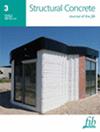Automatic assessment of the fatigue life of cables of cable‐stayed bridges by on‐line monitoring
IF 3.3
3区 工程技术
Q2 CONSTRUCTION & BUILDING TECHNOLOGY
引用次数: 0
Abstract
To accurately and timely evaluate the long‐term performance of cables in cable‐stayed bridges, an automatic perception technology scheme by on‐line monitoring of cable vibrations is proposed for the fatigue damage evaluation of in‐service cables. In the fatigue‐stress amplitude of cables, the stress produced by tension changes caused by external actions like traffic, wind, and temperature is the main component. When cables vibrate significantly, the stress caused by changes in cable vibration‐induced additional stress should not be neglected. Besides axial stress, bending stress is also significant in cable fatigue damage analysis. To make cable fatigue life prediction closer to real engineering scenarios, this factor should be considered. First, based on the cable dynamic stiffness theory, a method is proposed for the automatic gathering of the actual full‐stress time history of a cable by on‐line vibration monitoring. Furthermore, based on Miner's linear fatigue damage accumulation theory, an automatic fatigue life assessment method is proposed and applied to the vibration monitoring data of cables on an operational bridge. The results indicate that the proposed technology realizes automatic on‐line monitoring of cable forces and fatigue assessment of cables. Through statistical analysis of cable fatigue stress amplitude, it was determined that in cable‐stayed bridges, compared to long cables, short cables are more sensitive to external variable loads, typically experiencing larger and more frequent tension changes, and are more prone to fatigue. Therefore, short cables should be given more attention when analyzing cable fatigue in cable‐stayed bridges.通过在线监测自动评估斜拉桥缆索的疲劳寿命
为了准确、及时地评估斜拉桥缆索的长期性能,提出了一种在线监测缆索振动的自动感知技术方案,用于在役缆索的疲劳损伤评估。在缆索的疲劳应力振幅中,交通、风和温度等外部作用引起的拉力变化所产生的应力是主要组成部分。当电缆发生剧烈振动时,电缆振动变化引起的附加应力也不容忽视。除了轴向应力,弯曲应力在电缆疲劳损伤分析中也很重要。为使电缆疲劳寿命预测更接近实际工程情况,应考虑这一因素。首先,基于电缆动态刚度理论,提出了一种通过在线振动监测自动收集电缆实际全应力时间历程的方法。此外,基于 Miner 的线性疲劳损伤累积理论,提出了一种自动疲劳寿命评估方法,并将其应用于运营桥梁上的缆索振动监测数据。结果表明,所提出的技术实现了对缆索力的自动在线监测和缆索疲劳评估。通过对缆索疲劳应力幅值的统计分析,可以确定在斜拉桥中,与长缆索相比,短缆索对外部可变荷载更加敏感,通常会经历更大、更频繁的张力变化,更容易出现疲劳。因此,在分析斜拉桥的缆索疲劳时,应更多地关注短缆索。
本文章由计算机程序翻译,如有差异,请以英文原文为准。
求助全文
约1分钟内获得全文
求助全文
来源期刊

Structural Concrete
CONSTRUCTION & BUILDING TECHNOLOGY-ENGINEERING, CIVIL
CiteScore
5.60
自引率
15.60%
发文量
284
审稿时长
3 months
期刊介绍:
Structural Concrete, the official journal of the fib, provides conceptual and procedural guidance in the field of concrete construction, and features peer-reviewed papers, keynote research and industry news covering all aspects of the design, construction, performance in service and demolition of concrete structures.
Main topics:
design, construction, performance in service, conservation (assessment, maintenance, strengthening) and demolition of concrete structures
research about the behaviour of concrete structures
development of design methods
fib Model Code
sustainability of concrete structures.
 求助内容:
求助内容: 应助结果提醒方式:
应助结果提醒方式:


